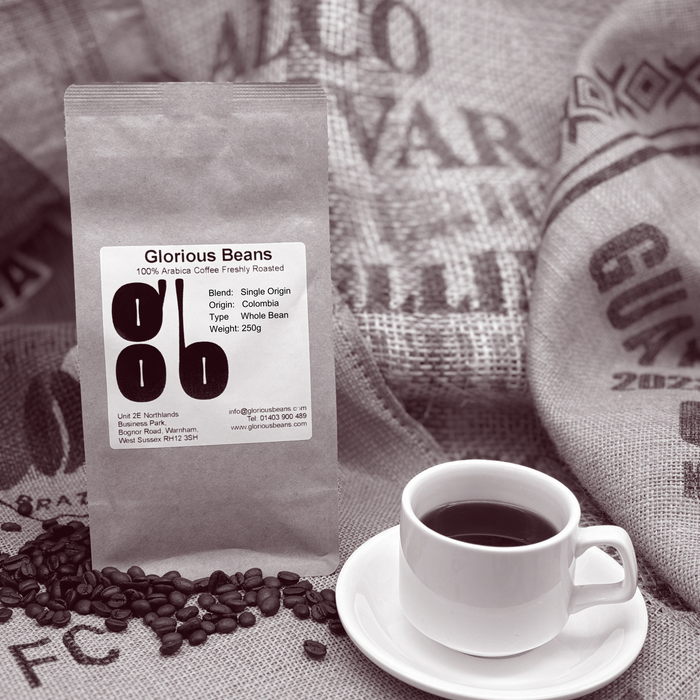Comprehending Coffee Beans: the Journey From Coffee to Blended Coffee Beans

The Origins of Coffee: An International Point Of View
While you may believe of coffee as a modern staple, its beginnings trace back centuries, intertwining with cultures throughout the world. The tale starts in Ethiopia, where tale claims a goat herder called Kaldi found the stimulating results of coffee beans after discovering his goats romping energetically after consuming them.
As profession routes broadened, coffee made its way to Europe in the 17th century, promptly obtaining popularity. Each culture added its unique twist to coffee preparation, enriching its history.
Cultivation and Harvesting of Espresso Beans
As coffee's journey evolved, the emphasis changed to the farming and harvesting of details bean selections, particularly those used for espresso. You'll find that espresso beans frequently originate from Arabica or Robusta plants, each offering unique tastes. The perfect expanding problems include high altitudes and abundant, well-drained soil, which improve the beans' quality.
Throughout the harvest, selecting methods differ. In some regions, employees hand-pick ripe cherries, making sure just the very best fruit mosts likely to handling. In various other locations, mechanical farmers are used, especially on larger ranches. When the cherries get to peak perfection for maximum flavor., timing is important; you want to collect.
Once gathered, the beans are prepared for handling, which is important in establishing their final taste. Understanding the cultivation and gathering procedures gives you insight right into what enters into your favored espresso, enriching your admiration for every cup.
Handling Techniques: From Cherry to Bean
Since you have actually learned regarding harvesting espresso beans, allow's explore how those cherries transform right into the coffee beans you love. You'll see just how different harvesting strategies impact taste, followed by the necessary steps of fermentation and drying out. We'll damage down the milling and grading process that determines your coffee's high quality.
Harvesting Methods Described
When it pertains to coffee, understanding harvesting techniques is crucial, considering that they directly influence the flavor and top quality of the beans you take pleasure in. There are 2 primary approaches: discerning picking and strip selecting. Selective selecting involves hand-picking only ripe cherries, ensuring you get the finest top quality beans. This approach frequently causes a richer taste account, though it's even more labor-intensive. On the various other hand, strip selecting means harvesting all cherries at the same time, despite ripeness. While it's quicker and more affordable, this can lead to a mix of tastes, impacting the last item. Eventually, the option of collecting strategy can greatly influence your coffee experience, so it's worth knowing how those beans made it to your cup.
Fermentation and Drying
After gathering, the next actions in handling coffee beans play a substantial role in shaping their flavor. You'll find that fermentation is important, as it aids damage down the mucilage bordering the beans, boosting their preference account. Relying on the technique, this process can last from a couple of hours to numerous days, with varying outcomes based upon temperature and moisture.
As soon as fermentation is total, drying adheres to, which is similarly essential. You can select from sun-drying or mechanical drying out techniques. Sun-drying allows the beans to soak up flavors from the setting, while mechanical drying out guarantees constant moisture levels despite weather condition. Proper drying out is necessary to protect against mold and maintain the beans' high quality, inevitably influencing your mug of coffee.
Milling and Grading Process
As fermentation and drying out set the stage for taste growth, the milling and grading process warranties that only the most effective coffee beans make it to your mug. This phase includes eliminating the outer layers of the coffee cherry, including the parchment and husk. After milling, the beans are arranged by dimension and weight, guaranteeing a consistent top quality. You'll find that grading assists recognize defects and classify beans, which influences taste and scent. Top quality beans get a greater grade, leading to a richer coffee experience. Once graded, the beans await product packaging and delivery, preserving their unique features. This meticulous procedure is vital for supplying the phenomenal taste you appreciate in every sip of your favored mixture.
Toasting Methods: Unlocking Flavor Prospective
When you roast coffee beans, the technique you pick can dramatically impact the flavor account. Understanding the relationship in between time, temperature level, and toasting methods is crucial to exposing the possibility of your mixture. Allow's check out just how these components collaborated to develop the excellent mug.
Toasting Approaches Clarified
While you might believe that all coffee toasting approaches generate the same results, the reality is that each strategy reveals one-of-a-kind taste possibilities in the beans. You can select between methods like drum toasting, air roasting, and even traditional frying pan roasting. Drum toasting utilizes a turning drum to uniformly distribute warmth, improving caramelization and creating a balanced taste. Air roasting, on the various other hand, distributes hot air around the beans, promoting a lighter roast with obvious level of acidity. Frying pan toasting enables for hands-on control however requires consistent focus to stay clear of burning. Each method has its nuances, so experimenting with various strategies can assist you find the ideal roast that lines up with your taste choices. Delight in the trip of discovering your suitable mug!

Effect on Taste Account
Different roasting approaches not only influence the procedure yet also greatly impact the taste account of the coffee beans. When you choose a light roast, you'll experience brilliant level of acidity and flower notes, showcasing the bean's origin. On the other hand, a tool roast balances acidity with sweet taste, frequently exposing chocolatey touches. Dark roasts, on the various other hand, bring out vibrant, smoky tastes, sometimes concealing the bean's special features. Each technique reveals different oils and compounds, causing a vast array of tastes. By try out various roasting styles, you can discover which profiles resonate with your palate. Comprehending these nuances assists you value the virtuosity behind your mug of coffee, boosting your total experience with every sip.
Time and Temperature Aspects
To launch the full flavor possibility of coffee beans, both time and temperature level during the roasting procedure play considerable functions. When roasting, you'll locate that higher temperatures can promptly create flavors, but if view website you hurry it, you may end up with burnt notes. Conversely, reduced temperatures enable an extra steady flavor development, showcasing the beans' distinct qualities.

Timing is equally as crucial; prolonging the roast too long can lead to a loss of acidity and illumination, while as well short a roast might leave the beans underdeveloped. Locating that wonderful area requires practice and experimentation. By readjusting these aspects, you can expose the rich, complicated tastes hidden within each bean, developing a genuinely impressive coffee experience.
The Art of Blending: Crafting One-of-a-kind Coffee Profiles

Beginning by picking a base coffee that gives a solid foundation. A brilliant Ethiopian bean can bring fruitiness, while an abundant Brazilian coffee adds body.
As you blend, bear in mind that each mix narrates. You're not simply making coffee; you're producing an experience. Take your time, preference frequently, and take pleasure in the trip of uncovering your trademark blend - Single Origin Espresso.
Brewing Techniques: Exactly How Prep Work Affects Flavor
Blending coffee opens a domain name of flavor possibilities, yet just how you make that blend can significantly influence your last mug. Different brewing approaches remove special flavors and aromas, so it's important to choose wisely. A French press allows oils and debris to remain, creating a rich, robust experience. On the various other hand, a pour-over highlights the coffee's quality and illumination, ideal for showcasing delicate notes.
Coffee, with its high stress, generates a concentrated shot that emphasizes sweet taste and crema. If you favor a lighter mixture, take into consideration a cool mixture approach; it produces a smooth, much less acidic taste.
Ultimately, experimentation is vital. Adjusting variables like water temperature level, grind size, and make time can change your coffee's profile. Embrace the art of developing to find the flavors concealed in your coffee blends. The right technique can elevate your experience to new elevations.
The Future of Coffee: Sustainability and Development
As the coffee sector progresses, sustainability and advancement are ending up being crucial for attending to environmental challenges and meeting customer demands. You'll see that more coffee firms are embracing environment-friendly techniques, from sourcing beans fairly to applying sustainable farming techniques. These shifts not only assist the earth yet also enhance the high quality of the coffee you appreciate.
You could see innovations like biodegradable packaging and water-saving brewing techniques that minimize waste. Advanced modern technology, such as blockchain, is additionally coming to be popular, guaranteeing transparency in the supply chain, which allows you to trace your coffee back to its origins.
In addition, spending in neighborhood areas and sustaining farmers via fair trade efforts promotes a much more sustainable coffee environment. As you drink your next mug, keep in mind that your selections can add to a brighter future for coffee. By selecting sustainable brands, you're not simply enjoying a beverage; you're making a favorable influence on the world.
Frequently Asked Questions
What Is the Distinction Between Arabica and Robusta Beans?
Arabica beans are smoother, sweeter, and have a greater acidity, while robusta beans are stronger, more bitter, and consist of more caffeine. You'll observe these distinctions in flavor and scent when making your coffee.
Exactly How Does Altitude Affect Coffee Bean Taste?
Elevation impacts coffee bean taste substantially. Greater altitudes create beans with brighter acidity and facility tastes, while lower altitudes commonly generate beans that are much heavier and much less nuanced. You'll discover these differences in your mug!
What Are the Health And Wellness Benefits of Alcohol Consumption Coffee?
Consuming coffee can boost your power, enhance psychological focus, and even boost physical efficiency. It's rich in anti-oxidants, may reduce the danger of specific conditions, and can advertise a much healthier you could try here metabolic process when eaten in moderation.
Can Coffee Beans Be Recycled for Developing?
Yes, you can recycle coffee beans for brewing, yet the flavor may be weaker. If you enjoy exploring, attempt recycling them in different methods, like chilly mixtures or contributing to smoothie mixes for an extra kick.
Exactly how Should I Shop Coffee Beans for Quality?
To maintain your coffee beans fresh, save them in a closed container in a trendy, dark location. Prevent revealing them to light, warm, he said or moisture, as these aspects can swiftly deteriorate their flavor and fragrance.
Comprehending Coffee Beans: the Trip From Coffee to Blended Coffee Beans.
Now that you have actually learned concerning gathering coffee beans, let's discover just how those cherries change right into the coffee beans you enjoy.When you roast coffee beans, the approach you pick can significantly affect the taste account - Single Origin Espresso.While you could assume that all coffee toasting methods produce the same results, the fact is that each technique exposes special taste possibilities in the beans.Various roasting techniques not just affect the process but also greatly affect the flavor account of the coffee beans